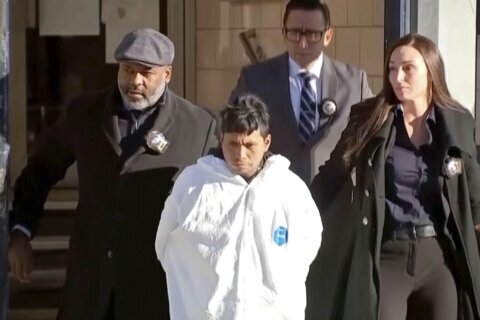
Noelia Sanchez was born in the rolling farmlands of southwest Missouri, where her Mexican parents worked as seasonal farmworkers in the 1950s.
When she was 1, Noelia and her mother, Aurora, who had no work documents, were rounded up with dozens of other immigrants in a Texas town near the border. The U.S.-born child and her mother were forced to go to Mexico along with hundreds of thousands of other people.
Their deportations were part of a U.S. government effort that was known in official papers and the media as “Operation Wetback.” The term “wetback,” which was used to describe Mexicans who swam or waded across the Rio Grande, is considered a racial slur.
Donald Trump has lauded the Eisenhower-era raids without using their name since he first ran for president and is now promising voters he would begin the largest domestic deportation operation in American history, exceeding the 1950s. He has escalated his verbal attacks on immigrants as he seeks a second term, telling supporters twice in recent weeks that immigrants were “poisoning the blood of our country.”
People affected by “Operation Wetback” and historians on immigration argue Trump is using fragments of history and rhetoric for political reasons while discounting his own administration’s failures to carry out mass deportations, even as it separated families at the U.S.-Mexico border and enacted sweeping restrictions on asylum.
“Families were divided by misapplied immigration policies and discriminatory immigration policies specifically geared toward Indigenous people, Mexican Americans, Latinos,” said Joaquin Sanchez, Noelia’s son, who is now an immigration attorney in Chicago. “These are the types of policies that my family has witnessed for generations.”
“Operation Wetback” coincided with a guest worker program that provided legal status to hundreds of thousands of largely Mexican farm workers. Noelia Sanchez, who was born in Missouri, and her mother were able to get their papers in about a year and return to settle in Chicago.
The administration of President Dwight D. Eisenhower launched a military-style campaign in the summer of 1954 seeking to remove Mexican immigrants who were in the country illegally. The operation followed several other deportation efforts of the 1940s and 1950s.
Scholars have challenged the 1 million arrests reported under that summer operation, saying that they had included figures from previous years and that the number for that entire year was actually much smaller at about 250,000.
The government relied on scare tactics to prompt people to self-deport so that they could have another chance to return to the U.S.
Experts have highlighted it was no coincidence the deportation drive happened as farmers were looking for guest workers under the Bracero program that began in the 1940s, aimed at allowing Mexican farmworkers to enter the country and work in the U.S. legally. The program excluded women and children, driving some families to enter the country illegally to remain together.
Adam Goodman, a professor of Latin American and Latino Studies at the University of Illinois at Chicago, wrote in his book “The Deportation Machine” that organizations such as the ACLU contacted immigration authorities in Chicago and ultimately advised immigrants who were in the country illegally to return to Mexico. Those groups sent a press release with a brochure to all newspapers in Illinois to give the deportation campaign more publicity.
“It was a terror campaign that was designed to scare people from the country,” said UCLA history professor Kelly Lytle Hernández. “It was really a PR campaign designed to terrorize communities into self-deporting.”
Hernandez said the administration would round up a sizable number of people, broadcast it and announce they were traveling to other towns. “There is no way the United States had that force to affect that number of deportations.”
Trump often labels immigration as dangerous in his speeches, suggesting people crossing the border are criminals who are trying to invade the U.S. and bring diseases.
Speaking in Ankeny, Iowa, in September, he said, “Following the Eisenhower model, we will carry out the largest domestic deportation operation in American history.”
He invoked the same operation in 2015 when he was first running for president.
But his administration did not deport millions during his four-year presidency as he promised before and after becoming president. Just as in the 1950s, the U.S. government was limited in how many deportations it could carry out at one time.
According to the Migration Policy Institute, the Trump administration deported about one-third as many immigrants in the country illegally from the interior during its first four fiscal years as the administration of President Barack Obama during the same time frame.
Enforcement sweeps take months of planning, and arresting an immigrant can often require days of surveillance. Officers don’t usually carry search warrants, and advocates warn immigrants not to open their doors. U.S. Immigration and Customs Enforcement often struggled to find adequate detention space during the Trump administration, and people can fight their deportation cases for months or years.
The Trump campaign did not respond to a request for information on why his administration did not come close to deporting millions and how a second term would conduct such a large-scale effort.
The Trump administration was more hostile to immigration than any administration in decades. Trump prevented people from applying for asylum at the southwest border, separated children from their families, and built a border wall in environmentally sensitive areas.
Advocates and extremism experts have noted his language echoes writings from Hitler about the “purity” of Aryan blood, which Nazi Germany used to justify murdering millions of Jews during World War II.
Well into his term in 2019, Trump announced on Twitter that he would deport millions the day before he was launching his reelection bid.
Florida Gov. Ron DeSantis, who is running against Trump for the Republican presidential nomination, hit Trump for his immigration record in the last GOP debate.
“He did say in 2016 he’d have the largest deportation program in history. He deported less than Barack Obama did when Barack Obama was president,” he said. “Some of these policies he ran on in ’16, I was cheering him on then, but he didn’t deliver it.”
Both DeSantis and Trump have touted the Eisenhower program as a model. Several candidates in the field have talked about using deadly force at the border or sending the U.S. military into Mexico.
Joaquin Sanchez’s grandmother, now 92, still lives in Chicago, in a home she owns a few blocks away from a proposed temporary shelter for newly arriving migrants.
“Grandma laughs at her own experience because she was able to come back and look at her now, and look at her kids,” he said. “She’s had an incredible trajectory.”
Copyright © 2024 The Associated Press. All rights reserved. This material may not be published, broadcast, written or redistributed.








